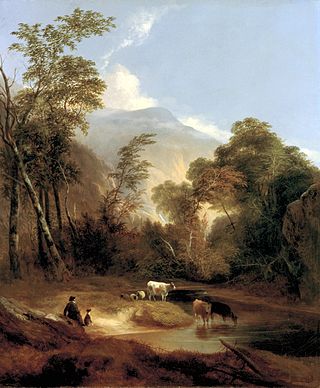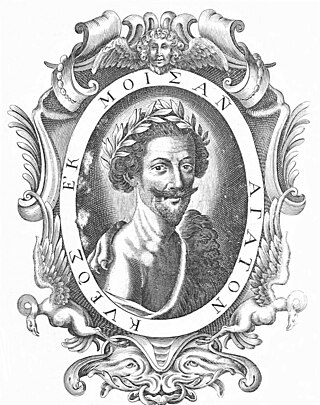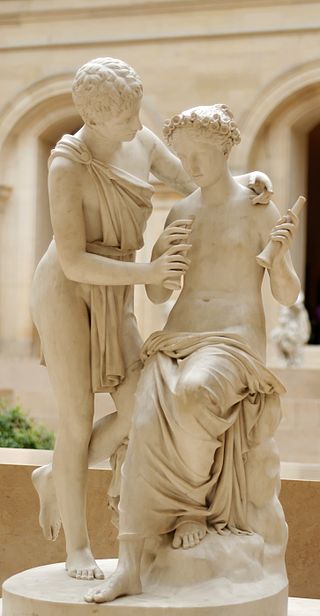
Don Quixote is a Spanish epic novel by Miguel de Cervantes. It was originally published in two parts, in 1605 and 1615. Considered a founding work of Western literature, it is often labelled as the first modern novel and the greatest work ever written. Don Quixote is also one of the most-translated books in the world and one of the best-selling novels of all time.

Sir Philip Sidney was an English poet, courtier, scholar and soldier who is remembered as one of the most prominent figures of the Elizabethan age. His works include a sonnet sequence, Astrophel and Stella, a treatise, The Defence of Poesy and a pastoral romance, The Countess of Pembroke's Arcadia.

Jacopo Sannazaro was an Italian poet, humanist, member and head of the Accademia Pontaniana from Naples.

The pastoral genre of literature, art, or music depicts an idealised form of the shepherd's lifestyle – herding livestock around open areas of land according to the seasons and the changing availability of water and pasture. The target audience is typically an urban one. A pastoral is a work of this genre. A piece of music in the genre is usually referred to as a pastorale.
This article presents lists of literary events and publications in the 16th century.

Jorge de Montemor was a Portuguese novelist and poet, who wrote almost exclusively in Spanish. His most famous work is a pastoral prose romance, the Diana (1559).

Honoré d'Urfé, marquis de Valromey, comte de Châteauneuf was a French novelist and miscellaneous writer.

Daphnis and Chloe is a Greek pastoral novel written during the Roman Empire, the only known work of second-century Hellenistic romance writer Longus.

La Galatea was Miguel de Cervantes’ first book, published in 1585. Under the guise of pastoral characters, it is an examination of love and contains many allusions to contemporary literary figures. It enjoyed modest success, but was not soon reprinted; its promised sequel was never published.

Arcadia refers to a vision of pastoralism and harmony with nature. The term is derived from the Greek province of the same name which dates to antiquity; the province's mountainous topography and sparse population of pastoralists later caused the word Arcadia to develop into a poetic byword for an idyllic vision of unspoiled wilderness. Arcadia is a poetic term associated with bountiful natural splendor and harmony. The 'Garden' is often inhabited by shepherds. The concept also figures in Renaissance mythology. Although commonly thought of as being in line with Utopian ideals, Arcadia differs from that tradition in that it is more often specifically regarded as unattainable. Furthermore, it is seen as a lost, Edenic form of life, contrasting to the progressive nature of Utopian desires.

The Countess of Pembroke's Arcadia, also known simply as the Arcadia, is a long prose pastoral romance by Sir Philip Sidney written towards the end of the 16th century. Having finished one version of his text, Sidney later significantly expanded and revised his work. Scholars today often refer to these two major versions as the Old Arcadia and the New Arcadia. The Arcadia is Sidney's most ambitious literary work by far, and as significant in its own way as his sonnets.
Gaspar Gil Polo, Spanish novelist and poet, was born at Valencia.
The Careless Shepherdess is a Jacobean era stage play, a pastoral tragicomedy generally attributed to Thomas Goffe. Its 1656 publication is noteworthy for the introduction of the first general catalogue of the dramas of English Renaissance theatre ever attempted.
Sir Clymon and Sir Clamydes is an early Elizabethan stage play, first published in 1599 but written perhaps three decades earlier. It is often regarded as a characteristic example—perhaps the best surviving example—of the type of drama that was extremely popular in the early Elizabethan period. The work "best represents the characteristics of pre-Greenian dramatic romance."
Nationality words link to articles with information on the nation's poetry or literature.

As You Like It is a pastoral comedy by William Shakespeare believed to have been written in 1599 and first published in the First Folio in 1623. The play's first performance is uncertain, though a performance at Wilton House in 1603 has been suggested as a possibility.
Batholomew Young or Yong was the translator of Montemayor's Spanish pastoral romance Diana into English.

Arcadia is a pastoral poem written around 1480 by Jacopo Sannazaro and published in 1504 in Naples. Sannazaro's Arcadia influenced the literature of the 16th and 17th centuries.
Gachupín is a Spanish-language term derived from a noble surname of northern Spain, the Cachopín of Laredo. It was popularized during the Spanish Golden Age as a stereotype and literary stock character representing the hidalgo class which was characterized as arrogant and overbearing. It may also be spelled cachopín, guachapín, chaupín or cachupino. The term remained popular in Mexico, where it would come to be used in the Cry of Dolores.













